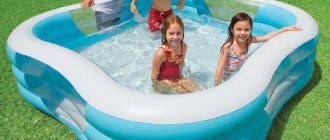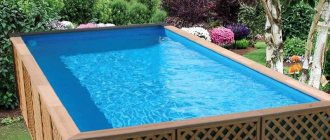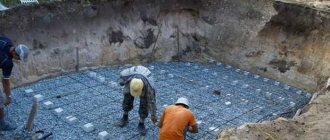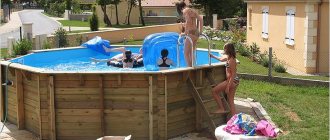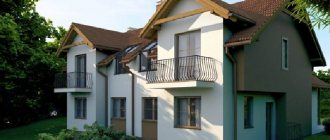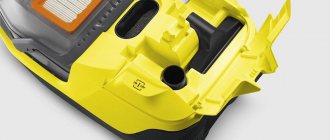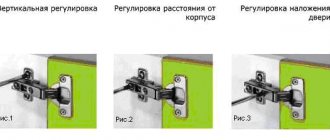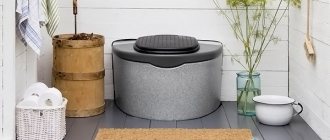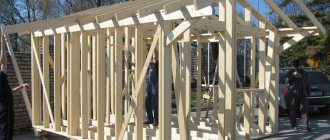Among the inhabitants of rural settlements and holiday villages, there is hardly a person who would refuse a swimming pool in the yard.
Not an inflatable paddling pool, but a real full-fledged pool where you can swim, jump and frolic without denying yourself anything.
It was always possible to build a sufficiently spacious and deep bathtub from concrete without problems, but difficulties arose with its lining, and if the quality was insufficient, the object could turn out to be very short-lived.
Today, this problem has finally lost its relevance, because now we have the ideal material for covering the inside of the bowl - polypropylene. In this article we will look at why it is so good and learn how to make a polypropylene pool with your own hands.
Characteristics of the material for finishing the concrete pool bowl
The reservoir will constantly be under the aggressive, destructive action of water. Therefore, facing materials must have the following qualities:
- Moisture resistance. It is best to use options with a water absorption coefficient of 0.14 to 1%. Porous, loose building materials will lead to leaks and subsequent destruction of the bowl.
- Resistant to chemical elements. Chemicals are constantly used to maintain a set pH level and disinfect water. When choosing what to decorate the walls of the pool with, remember that the facing material should not react negatively to contact with reagents and be destroyed by their influence.
- Immunity to microorganisms and mold. Warm water in an artificial reservoir is a favorable environment for various biological processes. Therefore, it is important to choose a material with a dense structure so that fungus or algae spores do not penetrate inside. Otherwise, it will not be possible to remove them; the only way out is to completely change the cladding.
- Long service life. The material must be durable. Water is 800 times denser than air; 1 m3 of liquid weighs a ton. Therefore, the cladding must withstand heavy loads.
Also, the outer walls of the structure should be easy to clean.
Methods for welding polypropylene sheets
The following technologies are used to connect PP parts:
- Polyfusion method: can be used for any thickness of material and provides the strongest connection. The edges of the two parts are heated with a special tool (contact method), after which they are pressed against each other with force.
- Manual extruder method: used for joining parts of relatively large thickness. The technology is based on the use of an additive element - a PP cord. When performing the operation, the installer must simultaneously monitor the soldering speed and the compression force of the edges being joined, which requires a certain skill.
- Hot air gun method: Using this method, thin-sheet PP with a wall thickness of 6 mm or less is joined. An additive cord is also used, but heating is carried out in a non-contact way - with a stream of hot air.
It is quite difficult to achieve high-quality and uniform heating in this way, therefore, even for an inexperienced craftsman, the seam is likely to turn out fragile.
If there is a swimming pool at the dacha, then the holiday becomes simply luxurious. But the pool requires maintenance, because the water quickly becomes dirty. To prevent your holiday from being spoiled by an unclean reservoir, it is recommended to install a filter. Do-it-yourself sand filter for a pool - recommendations for production and maintenance.
You will find a guide to making a frame shower cabin for a summer house in this material.
Types of pool finishes
The building materials market offers a wide range of materials for lining artificial reservoirs. Let's look at the advantages and disadvantages of each.
Finishing of swimming pools with PVC film
Polyvinyl chloride is a four-layer film 1.5 mm thick, reinforced with polyester fiber, with the addition of stabilizers that protect against the aggressive effects of ultraviolet radiation. For aesthetics, it is coated with a thin acrylic layer, which gives the material gloss.
Installation of the liner takes place in 5 stages:
- before finishing a concrete pool, carefully clean the surface from roughness and plaster it to avoid sharp protrusions;
- a fastening strip or corners are installed along the perimeter of the bowl;
- to avoid condensation and damage to the material, lay geotextile fabric;
- attach the liner to the fastening elements, solder them at the joints with a construction hairdryer;
- the seams are rubbed with liquid plastic, so a solid PVC bag is obtained.
The advantages of the film include:
- service life under favorable conditions up to 20 years;
- resistance to sunlight and temperature changes;
- maintainability: when installing the film, an allowance is made in case the bowl shrinks;
- quickly installed;
- easy to clean.
Flaws:
- can be pierced with a sharp object;
- reacts negatively to direct contact with chlorine.
It is worth noting that the material is presented in a limited palette, which is also considered a disadvantage.
Finishing the pool bowl with mosaics
The material is ready-made slabs of small sizes, with small tiles of glass, ceramics or porcelain attached to them. There are plain and patterned ones. Laying is carried out using the following technology:
- clean the bowl from dust and plaster it;
- to ensure the tightness and integrity of the bowl, waterproofing is done;
- install beacon cords along which the masonry is carried out;
- waterproof white glue with an adhesion index of 2.5 MPa is applied in a thin layer to the surface of the bowl, removing excess with a notched spatula;
- apply the mosaic slab and lightly tap it with the handle of a spatula;
- masonry is carried out evenly in horizontal and vertical directions;
- at the final stage, the seams are grouted with moisture-resistant grout.
Mosaic is chosen for its advantages:
- presentable appearance;
- the ability to post panels and paintings;
- tile material together with glue and grout form an additional waterproofing layer;
- long service life;
- easy to care for and does not react to chemicals;
- Pools of complex shapes can be lined.
The main disadvantage of finishing pools with mosaics is their instability to negative temperatures. Also, the disadvantages include the high cost of material and facing work.
Pool tiling
For these purposes, porcelain, glass or ceramic fired at high temperatures are used. Laying occurs in stages by analogy with mosaic laying technology.
The tiles have found application in private and public pools. It has undeniable advantages:
- durable, able to withstand high pressure;
- not destroyed by chemicals, easy to clean;
- Abrasion resistant.
Despite the fact that the material is frost-resistant, it does not react well to sudden temperature changes. If a chip forms on the tile, after a while it will crack and fall off. Another disadvantage is that the seams need to be resealed every 3-5 years. But if you use epoxy grout, the seams will remain in their original form.
Finishing the pool with stone
Marble, granite, sandstone and rubble are used for cladding. Natural materials are laid using ceramic tile technology. For fixation, epoxy glue with a high level of adhesion is used. The materials have the following advantages:
- Granite.
Very durable, does not fade, does not wear out, is resistant to chips and temperature changes. Moisture-proof and not subject to changes under the influence of chemicals. - Marble
. Eco-friendly and antiseptic material – resistant to the formation of fungi. Not affected by ultraviolet radiation, responds well to temperature changes. It can be easily sanded, allowing you to remove scratches or small chips.
Natural stone also has its disadvantages. Granite is very heavy, which makes installation much more difficult. Wet marble is very slippery, so to avoid injury, do not use it to line the bottom and floor around the bowl.
Chemical compositions for water disinfection, in contact with marble, destroy its structure over time - it turns into ordinary chalk. Maintaining marble pools requires careful maintenance, specialized chemicals for disinfection and pH adjustment.
Finishing the pool with polypropylene
For cladding, plastic sheets with a thickness of 5 mm or more are used. The composition includes stabilizers, the outer side is covered with a glossy film for greater strength. The installation technology is similar to cladding with PVC film. But the joints on polypropylene are more noticeable.
Advantages:
- resistant to ultraviolet radiation, high and negative temperatures;
- light in weight, non-toxic, meets SanPin requirements;
- durable, withstands strong impacts and is not subject to deformation;
- elastic - this allows you to line bowls of any shape;
- holds heat well;
- fungus and algae do not penetrate the structure of the material;
- does not collapse under the influence of chemical reagents.
The disadvantage of polypropylene is that it is not suitable for outdoor swimming pools. Without water, plastic heats up and deforms, and in winter it freezes and cracks. This negatively affects the tightness of the bowl, susceptibility to repair and aesthetics.
Preparatory stage
Before you begin building a pool, you need to carry out preparatory work; the further progress of installation will depend on it.
Work on the construction of a swimming pool must begin with design ; The entire cycle of work will depend on what the owner “imagines” for himself. The choice of pool depth is of great importance. According to the European standard, a pool is built from 1 meter to 1.65.
It is necessary to choose the shape of the design bowl, which will be affected by the configuration of the site for the structure.
When choosing a bowl shape, you need to take into account that a complex option will require more time for maintenance and calculation of filtration power.
The main pastime in the pool is communication and entertainment on the rides. Therefore, be sure to think about the placement of horizontal bars, springboards, stairs, and slides.
If your family members cannot swim, there is no point in planning a pool that is 2-3 meters deep.
Before starting work, you need to choose the right place for the hydraulic structure; the pool should be located in a free area near the water supply, but away from vegetation.
To facilitate installation, it is necessary to make a diagram of the structure, and from it calculate the installation of hydraulic equipment.
The dimensions of the pool structure need to be increased by at least 1 meter wider around the perimeter of the size of the propylene bowl, since a free area for movement will be needed.
How to make a swimming pool for your summer house from polypropylene? Watch the installation video.
Painting the pool walls
Coating a bowl with paints and varnishes is a labor-intensive process and requires strict adherence to technology:
- clean the surface from dust and debris;
- treat with an acidic composition and rinse with water;
- cover the tank with sodium phosphate solution and also rinse it off, allow the walls to dry completely;
- degrease the surface, fill all microcracks;
- apply a primer and let the material dry completely;
- paint the pool.
Among the advantages can be noted:
- high elasticity, hydrophobicity, adhesion;
- painted surfaces do not slip when wet;
- resistance to temperature changes;
- does not deform and is not susceptible to physical stress.
Despite the advantages, this cladding option is not practical, especially for outdoor pools. The paint will have to be renewed after every winter. In closed artificial tanks, the service life is not much longer; the coating lasts for 3-5 years.
Rubber spraying
Rubber paint is a type of water-based acrylic paint and varnish. Easy to apply, when dry it forms a dense, elastic, waterproofing layer. The material is flexible, so it can withstand any deformation without collapsing or peeling off from the wall. It has high adhesion and dirt-repellent properties. When heated, it does not emit harmful substances and does not crack due to frost.
Rubber or latex paint is sprayed with a spray gun using a technology similar to the rules for painting a tank with conventional paints and varnishes.
We carry out calculations
Before construction, it is necessary to carry out calculations
Once you have chosen a suitable location, you can begin making calculations.
You can also install a plastic pool with your own hands in the house itself. But there are no typical cases for installing an indoor pool, so we are considering installing an outdoor pool bowl.
The hole should be dug with a margin of 20 centimeters on each side. The depth should be calculated based on the depth of the pool itself and its base cushion.
The base is installed 20 centimeters thick if the soil is sandy or gravel. If there is clay soil under the pillow, then the thickness of the foundation should be 25 centimeters.
Next, sketch out how water pipes, electrical wires and the tank’s own communications will be supplied. Note where the filter will be located, how much space it will take up and how to connect to the bowl.
Liquid rubber for waterproofing
Liquid rubber is ideal for waterproofing a swimming pool. It is a bitumen-polymer mastic that is applied to surfaces. This method allows you to obtain a seamless coating that well protects the reservoir from moisture. Sometimes it is combined with other insulation methods, such as film.
Liquid rubber is ideal for pool waterproofing
Since the substance is water-based, it can be easily applied by sprayers or rollers. In order for the material to harden later, it contains calcium chloride, which plays the role of a catalyst. Once applied, the salt draws out water, resulting in a hard but flexible coating.
The disadvantage of liquid rubber is its instability to sunlight. The bottom is usually protected from ultraviolet radiation by a thick layer of water, but the upper layers may crack or collapse.
Penetrating waterproofing
Coating waterproofing for swimming pools penetrates deep into the pores of concrete and clogs them, thereby preventing moisture from entering. The mixtures also use a special polymer. The composition can penetrate to a depth of half a meter. The mixture not only protects from moisture, but also increases frost resistance and prevents the development of fungi in concrete. The disadvantages include the fact that the material is quite difficult to work with. It is especially difficult to apply to joints, seams or equipment connections.
Tile
This option looks more interesting and allows you to choose from numerous color options. The tiles are laid using a specialized adhesive (usually epoxy with high adhesion rates). Laying the material usually starts from the bottom, moving to the walls. But, if the drain is located on one side, then it is better to install the tiles in rows. The material is laid on the walls, just like in any other room (for example, a bathroom). There is only one minor difference - thicker seams are made for the pool, which must be treated with grout that has high frost and moisture resistance.
If we talk about the advantages of tiles, they are obvious:
- The material is more reliable and durable.
- Looks much better than PVC film.
- High level of sealing.
- Due to the fact that special rough tiles are used for pools, it will be very difficult to slip on them.
- If one tile is damaged, it is not difficult to replace it.
The downside is the higher cost. It will also be difficult to lay the tiles evenly on your own if you do not have any experience working with such material. It will take more time. Also, when choosing tiles, you need to take into account important points.
Choosing the right tiles
As already mentioned, the tiles should be rough. In addition, it is worth:
- Purchase tiles with the highest possible water-repellent properties (for imported tiles the optimal value is 0.14%, and for domestic tiles 1%).
- Buy products with increased adhesive properties. The back of the tile should have grooves rather than a flat surface.
- Use only high-quality waterproof adhesive.
Healthy! It is better to purchase titanium grout. Such compositions are not susceptible to the formation of fungus and mold.
- Give preference to Italian, Portuguese and domestic products. These tiles are of higher quality.
- Choose not ceramic, but porcelain tiles for cladding the walls of a concrete pool. This option tolerates temperature changes much better. In addition, porcelain tiles have higher frost resistance and low water absorption. It gets dirty less and does not absorb dirt at all.
Connecting all systems to the bowl
Next, we connect all systems to the bowl using pipes. Next, we will permanently concrete them or fill them with earth, so here we need to do everything as efficiently as possible.
Pipes are brought to the pool through small trenches
After all communications have been completed, we check all systems for leaks and fill the pool to 10 centimeters.
Laying the foundation
When the pit is completely ready, all measurements have been taken again and no errors have been found, you can begin laying the foundation for the future bowl.
The so-called pool cushion
The first layer of crushed stone is laid in order to level the site. We level it using a flat board with an attached level. Next, we compact this layer with special equipment. If you don’t have this at your disposal, then you can try to stamp it down as tightly as possible.
Some limit themselves exclusively to the first layer, but we strongly do not recommend this, as this will seriously affect the life of the pool.
Next, along the perimeter we prepare formwork for pouring concrete 15-20 centimeters high. The concrete layer can be installed without reinforcement, but if possible, then the extra rigidity of the foundation will not hurt. We pour the foundation and let it dry and completely harden for 3 days.
The third and last layer is polystyrene foam 3-4 centimeters thick. After laying it, you can consider laying the foundation completed successfully.
Choice
The choice is purely individual. We will not advise you on a specific finishing material for a number of reasons:
- Each material costs differently. Start from your budget.
- Some materials are suitable for indoor pools, while others can only be installed with open ones.
- Everyone has positive and negative properties.
- The preference factor is also taken into account. Some people like marble, others are crazy about mosaic tiles.
We have described the main characteristics of the most popular finishing materials for arranging swimming pools. Choose the material that you think is most relevant.

